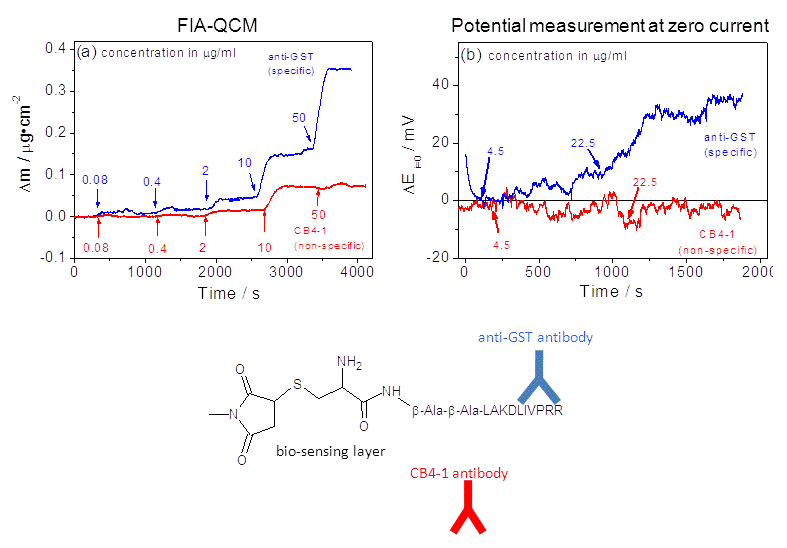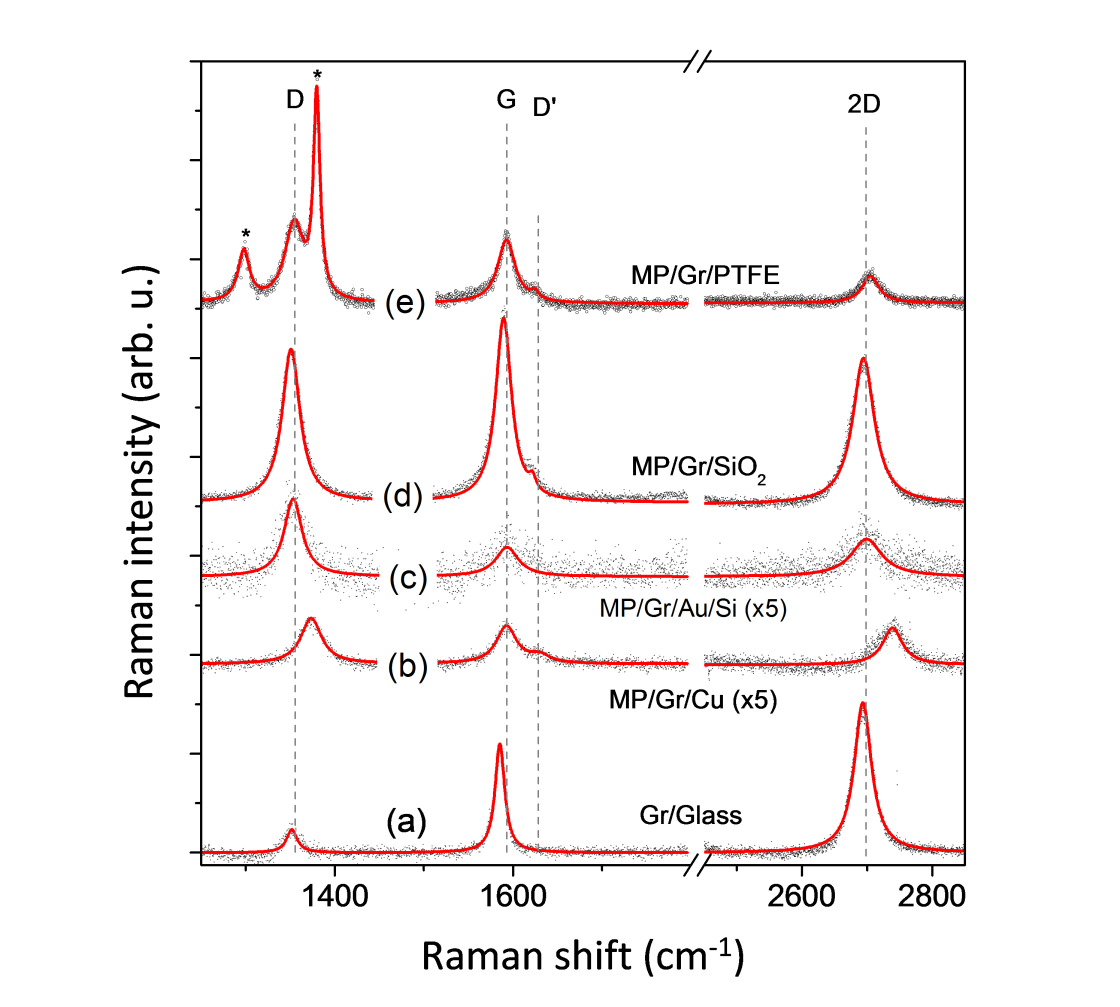Institute Silicon Photovoltaics
Sensing of biomolecules
The substrate is functionalized by a linker molecule with an anchoring part where the recognition element is bound. The next step is the specific binding of the peptide, antibody etc. as sketched in Fig. 1 coupled with a detection of the recognition process by means of mass change as measured by QCM or optical verification (fluorescence spectroscopy, in-situ infrared spectroscopy) or electrical measurements (impedance spectroscopy, voltammetry).
The linker molecule can be grafted onto the substrate surface by different techniques. We use:
- Electrochemical deposition via diazonium salts followed by the amide bonding of the anchor [1-4], see Fig. 2.
- Chemical deposition via hydrosylation [5] followed by the amide bonding of the anchor (Fig. 3).
The bio-sensing layer using route 3 in Fig. 2 (direct maleimide functionalization) showed a 7-times higher sensitivity towards the anti-GST antibody than CB4-1 antibody (Fig. 4). The detection of the specific binding event of the antibody was performed using Flow-Injection-Analysis Quartz-Crystal-Microbalance (FIA-QCM) and voltametric measurements [4].

Fig. 4: (a) Frequency response of the Au electrodes (QCM) modified by maleimidophenyl and cys-peptide as a function of time after addition of the solutions of specifically binding anti-GST antibody and non-specific CB4-1 antibody with different concentrations from 0.08 to 50 µg/ml; (b) electrical response of a Si electrode modified by maleimidophenyl and cys-peptide after addition of anti-GST antibody and CB4-1 antibody.
Large-area graphene based sensor
Graphene is a conducting substrate that can be functionalized homogeneously [6,7] and transferred to any other material conducting or non-conducting without any remarkable loss of functionality [7].


Fig. 5: Top: Sketch of the surface functionalization of graphene by maleimido-phenyl (MP) via electrochemical reduction of p-Maleimidobenzene-tetrafluoroborate. Bottom: Functionalization of graphene on copper and subsequent transfer on another substrate (here oxidized Si wafer).

Fig. 6: Raman spectra of a) unmodified graphene (Gr) transferred on glass, b) maleimidophenyl (MP) functionalized graphene on copper; MP/Gr transferred to c) thick SiO2 layer on Si, to d) Au/Si and to e) PTFE foil. The spectra are shifted vertically for clarity. The * marked bands are due to PTFE. Excitation with 488 nm.
references
[1] Infrared spectroscopic study of the amidation reaction of aminophenyl modified Au surfaces and p-nitrobenzoic acid as model system; Zhang, X.; Sun, G.; Hinrichs, K.; Janietz, S.; Rappich, J.; Phys Chem Chem Phys 12 (2010), 12427-12429.
[2] Infrared spectroscopic ellipsometry (IRSE) and X-ray photoelectron spectroscopy (XPS) monitoring the preparation of maleimide-functionalized surfaces: from Au towards Si (111); Sun, G.; Hovestaedt, M.; Zhang, X.; Hinrichs, K.; Rosu, D.M.; Lauermann, I.; Zielke, C.; Vollmer, A.; Löchel, H.; Ay, B.; Holzhütter, H.-G..; Schade, U.; Esser, N.; Volkmer, R.; Rappich, J.; Surf. Interface Anal. 43 (2011) 1203–1210.
[3] Chehimi M.M.; editor. Aryl diazonium salts: new coupling agents in polymer and surface science. Weinheim: Wiley-VCH Verlag; 2012; ISBN 10: 3527329986 / 3-527-32998-6
[4] Electrochemical functionalization of gold and silicon surfaces by a maleimide group as a biosensor for immunological application; Zhang, X.; Tretjakov, A.; Hovestaedt, M.; Sun, G.; Syritski, V.; Reut, J.; Volkmer, R.; Hinrichs, K.; Rappich, J.; Acta Biomaterialia 9 (2013) 5838–5844.
[5] In situ monitoring of the electronic properties and the pH stability of grafted Si(111); Aureau, D.; Rappich, J.; Moraillon, A.; Allongue, P.; Ozanam, F.; Chazalviel, J.-N.; J. Electroanal. Chem. 646 (2010) 33–42.
[6] Quantifying the electrochemical maleimidation of large area graphene; Rösicke, F.; Gluba, M.A.; Hinrichs, K.; Sun, G.; Nickel, N.H.; Rappich, J.; Electrochem. commun. 57 (2015) 52.
[7] Functionalization of any substrate using covalently modified large area CVD graphene; Rösicke, F.; Gluba, M.A.; Shaykhutdinov, T.; Sun, G.; Kratz, C.; Rappich, J.; Hinrichs, K.; Nickel, N.H.; Chem. Commun. 53 (2017) 9308.



